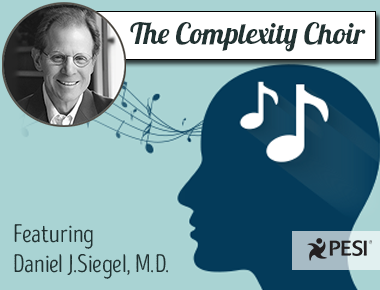The Complexity Choir

These days, before I define mental well-being in my lectures, I often ask for volunteers to sing in a "complexity choir." Experienced singers usually break the ice and come bounding up to the front of the room, while others, initially more reticent, slowly find their way to join in. Whether my audience is parents or teachers, therapists or scientists, I know that the best way to help them grasp the power of integration is through immersion in direct experience.
My first request is that the newly assembled choir members all sing the same note at the same time, simply humming along in unison. Someone comes up with a mid-range pitch and they quickly settle into a uniform sound. After about half a minute, I hold up my hand to stop them and then make another request. This time I ask them to cover their ears so they can't hear one another, and then, at my signal, launch individually into whatever song with whatever words they'd like to sing. The audience usually laughs when the singers begin, but they quickly get restive, so I hold up my hand again.
Finally, I ask the singers to choose a song most of them are likely to know and then to sing it together, harmonizing freely as the spirit moves them. This may be the ultimate pickup ensemble, but it's remarkable to hear what happens as a group of teachers or psychotherapists sail into "Oh! Susanna" or "Amazing Grace" or "Row-Row-Row Your Boat." (And it's fascinating to me that more than half the time, the group chooses "Amazing Grace"--which apparently is one of the most harmoniously balanced songs in the Western tradition.) Once the melody is established, individual voices begin to emerge, weaving their harmonies above and below, playing off one another, moving intuitively toward a crescendo before the final notes. Faces light up in choir and audience alike; we are all swept into the flow of the singers' energy and aliveness. At these times, people have said--and I've experienced this as well--there is a palpable sense of vitality that fills the room.
At that moment we are experiencing integration at its acoustic best. Each member of the choir has his or her unique voice, while at the same time they are linked together in a complex and harmonious whole. One is never quite certain where the choir will take the song, but the surprises simply highlight the pleasure of a familiar, shared melody. This balance between differentiated voices on the one hand and their linkage on the other is the embodiment of integration.
And what about the first two exercises? As you surely could predict, the single-note humming is unchanging, rigid—and after a while, dull and boring. The initial excitement and risk of volunteering gives way to the monotony of the task. The singers may be linked, but they cannot express their uniqueness, their individuality. When differentiation is blocked, integration cannot occur. Without the movement toward integration, the entire system moves away from complexity -- away from harmony--and into rigidity.
On the other hand, when the singers close their ears and sing whatever they want, what emerges is cacophony, a chaotic outpouring of sound that often creates a sense of anxiety and distress in the listeners. Now there is no linkage -- only differentiation. When integration is blocked in this way, we also move away from complexity, away from harmony. But this time we move toward chaos, not rigidity.
As the singers settle into their seats again, I sum up the point of the exercise: It is the middle way between chaos and rigidity--the flow of independent voices linked together in harmony--that maximizes both complexity and vitality. This is the essence of integration.
I've come to believe that integration is the key mechanism beneath both the absence of illness and the presence of well-being. Integration -- the linkage of differentiated elements of a system -- illuminates a direct pathway toward health. It's the way we avoid a life of dull, boring rigidity on the one hand, or explosive chaos on the other. We can learn to detect when integration is absent or insufficient and develop effective strategies to promote differentiation and then linkage. The key to this transformation is cultivating the capacity for mindsight.
 |


